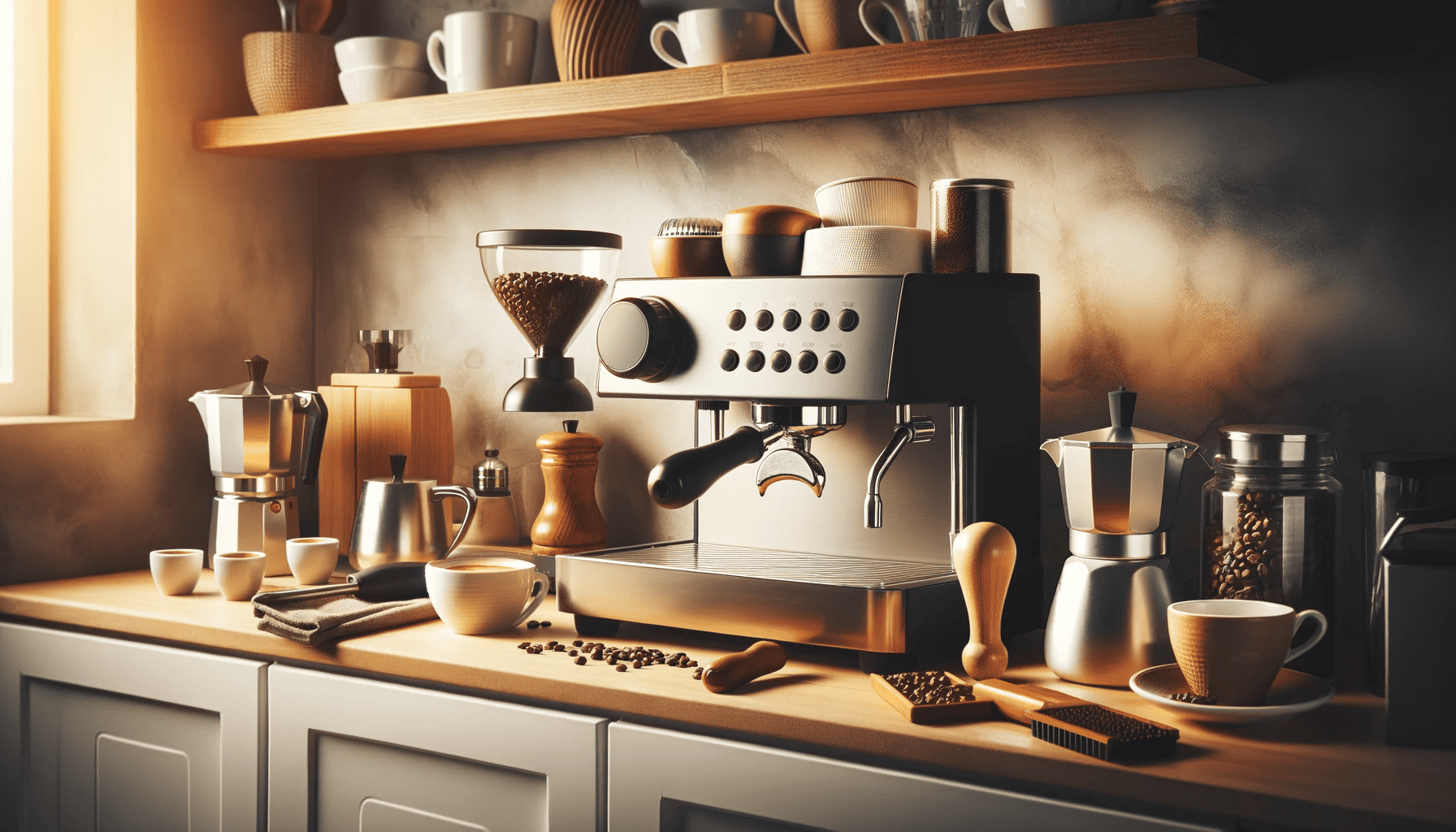Entering the world of home espresso making is like stepping into a new country where the language is familiar yet distinctly specialized. Understanding espresso machine terminology is not just about mastering a set of words; it’s about immersing yourself in a culture that cherishes precision, craftsmanship, and the art of a perfect cup.
For newcomers, this glossary is your friendly guide, helping you navigate t ough unfamiliar terms. It’s not just a list of definitions; it’s a bridge to understanding the subtleties and nuances of espresso making. As you learn, you’ll start to see how each term fits into the larger picture of creating that ideal espresso shot.
For the experienced baristas, this glossary is a valuable reference. Even the most skilled among us encounter unfamiliar terms or need a refresher. It’s also a chance to deepen your understanding and perhaps learn a new trick or two.
Let’s be clear: knowing the language of espresso machines is more than jargon. It’s the first step to truly mastering the craft of home espresso making. It allows you to precisely communicate your techniques, troubleshoot issues, and share your experiences with a community that’s as passionate about espresso as you are.
Understanding this terminology is about empowering yourself in the world of espresso. It’s about gaining the confidence to experiment with your brew, to understand what went wrong (or right!), and to connect with others who share your passion. So, let’s dive in and start speaking the language of espresso!
< class="wp-block-separator has-alpha-channel-opacity"/>Basic Terms: Understanding Your Machine
When you start using an espresso machine at home, it’s like learning to drive a new car. You need to know what each part does to use it well. This section explains some basic terms to help you get started.
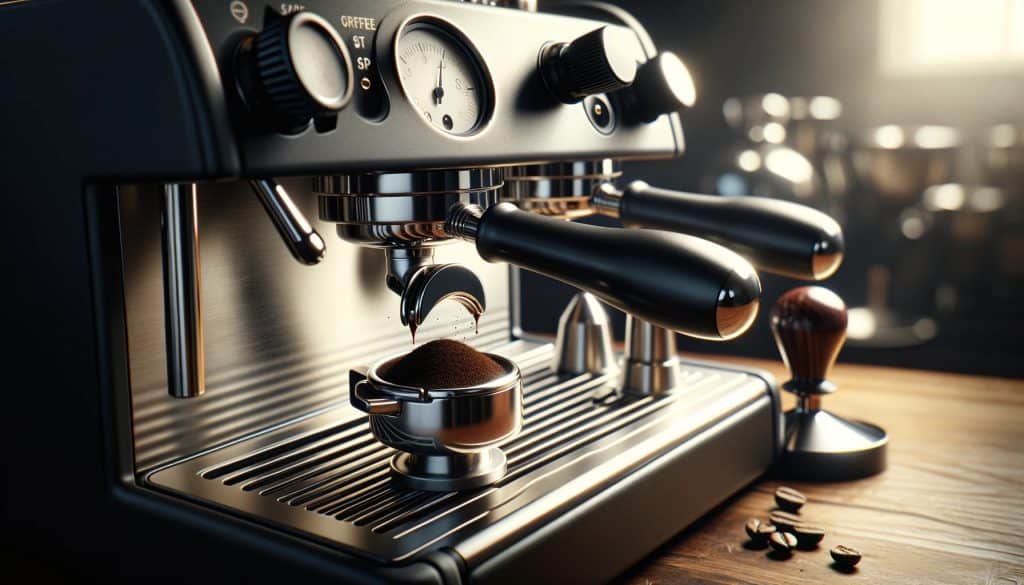
Group Head: The Heart of Brewing
- The group head is where your espresso comes to life. It’s the part of the machine where hot water meets the coffee grounds.
- Hyponyms:
- Portafilter: This is the handle you attach to the group head. It holds a basket with your coffee grounds.
- Shower Screen: This part is inside the group head. It spreads the water evenly over the coffee.
Portafilter: Your Espresso’s First Home
- This handle and basket are where you put your coffee grounds before brewing.
- Meronyms:
- Basket: This small container in the portafilter holds the coffee grounds.
- Handle: The part you hold when you attach or remove the portafilter from the group head.
Tamper: The Key to Perfect Coffee Grounds
- A tamper is a tool you use to press down the coffee grounds in the portafilter. It’s important for making a good espresso because it makes sure the water goes t ough the coffee evenly.
The Brewing Process Decoded
Understanding how your espresso machine works can be as fascinating as the drink it creates. In this section, we’ll break down the key elements of the brewing process.

Extraction: The Essence of Espresso
- Extraction is the process of hot water passing t ough the coffee grounds to create espresso. It’s like squeezing out all the flavor from the coffee.
- Hyponyms:
- Pre-infusion: This is when water first wets the grounds, allowing them to swell and release their flavors.
- Bloom: This term refers to the initial release of gas from the coffee grounds when water hits them, which is key for flavor extraction.
Shot Timing: The Stopwatch of Flavor
- The time it takes to pull an espresso shot is crucial. Too fast and it’s under-extracted, too slow and it’s over-extracted.
- Understanding the ideal extraction time is like hitting the sweet spot for the perfect cup of espresso.
Pressure Gauge: The Barista’s Barometer
- This gauge helps you monitor the brewing pressure. Think of it as a speedometer for your espresso machine.
- Proper pressure ensures that the water flows t ough the coffee at the right rate, extracting maximum flavor.
Milk Frothing Terminology
Exploring the art of milk frothing can transform your espresso experience. Let’s dive into the terms that will help you master this craft.

Steam Wand: The Artist’s Brush
- The steam wand is like a magic wand for milk. It steams and froths milk, creating that creamy texture we love in lattes and cappuccinos.
- Meronyms:
- Steam Tip: The part of the wand where steam comes out. It’s crucial for controlling the flow and texture of the milk.
- Valve: This controls the release of steam from the wand. Turning this is like controlling the intensity of your paintbrush strokes.
Microfoam: The Secret to Latte Art
- Microfoam is the fine, creamy froth that’s perfect for making latte art. It’s all about the texture – velvety and smooth.
- Achieving the right microfoam consistency is like finding the perfect consistency of paint for your masterpiece.
Frothing Pitcher: The Milk’s Canvas
- The frothing pitcher is where the milk frothing magic happens. It’s like a canvas for your milk art.
- The shape and size of the pitcher play a big role in how well you can froth milk. It’s like choosing the right size canvas for your painting.
Machine Maintenance Jargon
Understanding machine maintenance jargon is key to keeping your espresso machine in top shape. Let’s break down these essential terms.

Backflushing: The Espresso Machine’s Spa Treatment
- Backflushing is like giving your espresso machine a deep cleanse. It’s the process of cleaning the group head, where the coffee magic happens.
- Think of it like a spa day for your machine, ensuring every shot of espresso is as perfect as the first.
Descaling: Fighting the Hidden Enemy
- Descaling is about removing the mineral buildup that can clog your machine. This buildup happens over time, especially in areas with hard water.
- It’s like battling the hidden foes that can affect the taste of your coffee and the lifespan of your machine.
Water Hardness: The Invisible Influence
- Water hardness refers to the amount of minerals in your water. It’s an invisible factor that significantly impacts your machine’s maintenance.
- Understanding water hardness is like knowing the type of paint you’re using – some are easy on your brushes, others wear them down quicker.
Advanced Features in Modern Machines
Exploring advanced features in modern espresso machines reveals how they elevate the coffee-making experience. Let’s delve into these sophisticated functionalities.
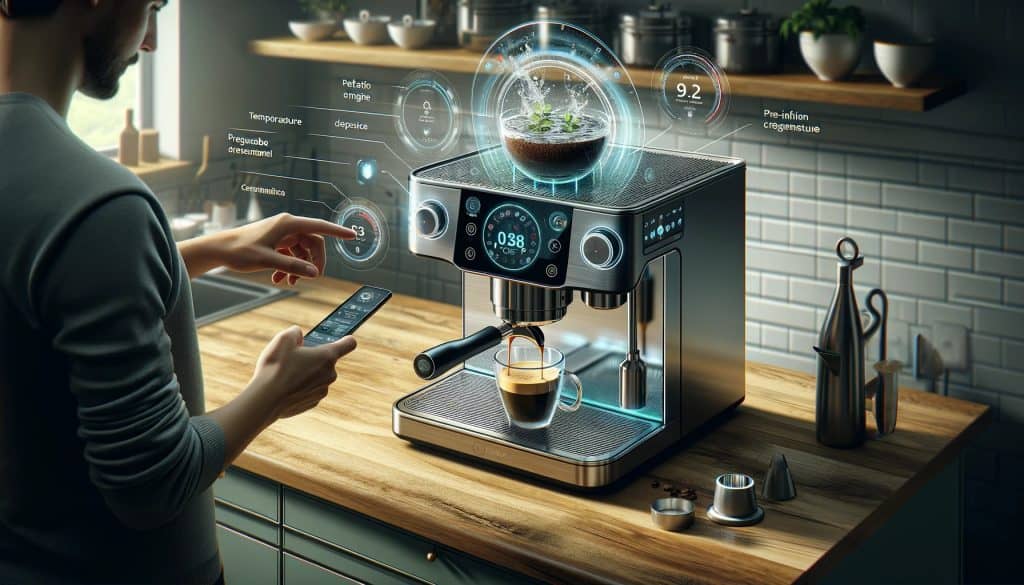
PID Controller: Mastering Temperature Precision
- The PID controller is a game-changer for temperature stability. It’s like having a precision thermostat for your espresso.
- It ensures every shot is brewed at the perfect temperature, crucial for extracting those rich, nuanced flavors.
Pre-infusion: Unlocking Flavor Secrets
- Pre-infusion is a technique that gently wets the coffee grounds before full extraction. Think of it as a flavor teaser, preparing the grounds to unleash their full potential.
- This step enhances flavor, making each espresso shot more consistent and delicious.
Programmable Settings: Your Espresso, Your Way
- Programmable settings are like having a barista inside your machine, ready to remember exactly how you like your espresso.
- They allow you to customize espresso shots to your preference, ensuring your coffee is always just the way you like it.
Types of Espresso Machines
Exploring the different types of espresso machines is crucial for understanding which best suits your coffee preferences and lifestyle. Let’s break down these types.
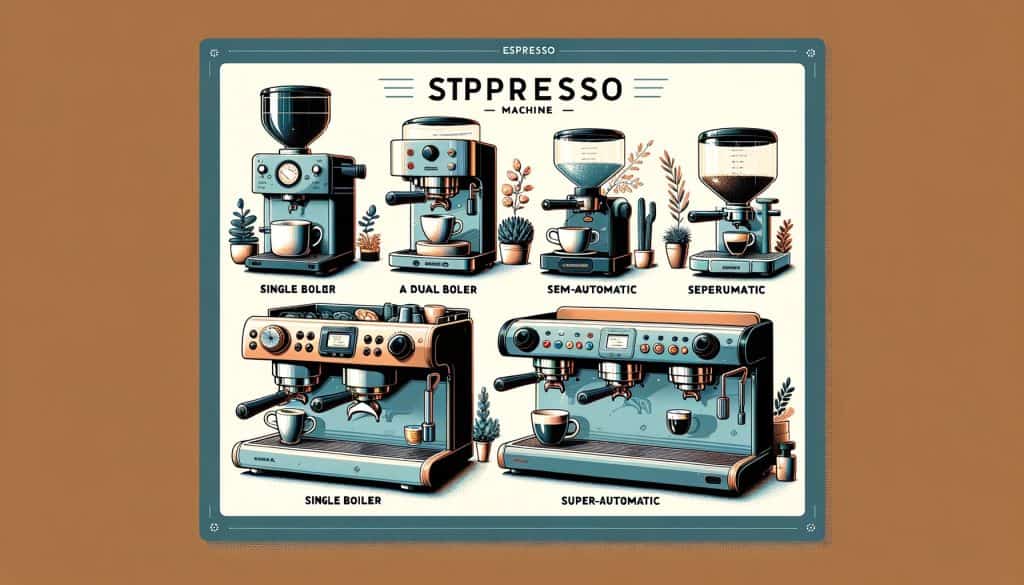
Single Boiler vs. Dual Boiler: Balancing Efficiency and Precision
- Single boilers are more compact and budget-friendly. They can brew and steam, but not simultaneously.
- Dual boilers, however, offer dedicated boilers for brewing and steaming. They’re ideal for multitasking and maintaining precise temperatures.
Semi-Automatic vs. Automatic vs. Super-Automatic: Choosing Your Level of Control
- Semi-automatic machines offer a balance of manual control and automated features. They’re perfect for those who enjoy being part of the brewing process.
- Automatic machines manage the brewing time for you, making consistent espresso with ease.
- Super-automatic machines are the epitome of convenience. They grind, tamp, brew, and sometimes even steam milk at the touch of a button.
Meronyms: The Essential Components
- Brewing Unit: The heart of the machine where the magic of espresso extraction happens.
- Water Reservoir: This component holds the water needed for brewing and steaming. Its capacity is crucial for determining how often you’ll need to refill it.
- Control Panel: The command center of the machine, where you make all the adjustments and settings to brew your perfect cup.
Grinder Terminology: Why Burr Grinders Lead the Pack
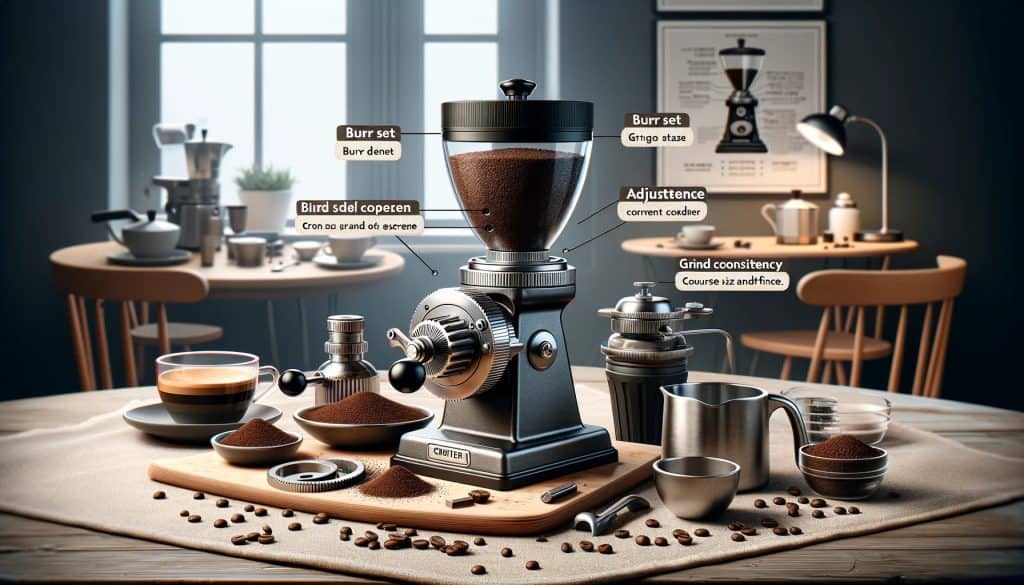
The Heart of Espresso Making
When it comes to crafting the perfect espresso at home, the importance of a good grinder is often underestimated. This piece focuses on why burr grinders are the top choice for coffee enthusiasts and how they influence the quality of your espresso.
Burr Grinder: The Gold Standard
A burr grinder isn’t just a tool; it’s the gateway to superior espresso. Unlike blade grinders, which chop beans unevenly, burr grinders crush beans between two burrs, ensuring a consistent grind. This uniformity is crucial because the size of your coffee grounds directly affects extraction during brewing.
Key Components of a Burr Grinder
- Burr Set: The two revolving abrasive surfaces that grind the beans. The quality of the burr set determines the uniformity of the grind.
- Adjustment Collar: This part allows you to control the grind size. Whether you want a fine grind for espresso or a coarser one for French press, the adjustment collar makes it possible.
Comparison of Grind Sizes and Brewing Methods
| Grind Size | Brewing Method |
|---|---|
| Fine | Espresso |
| Medium | Drip Coffee |
| Coarse | French Press |
Grind Size and Consistency: The Espresso Quality Maker
The size and consistency of your grind are non-negotiable for espresso. A fine, consistent grind is essential for extracting the full flavor without over-extracting, which can lead to bitterness. A burr grinder is the best tool for achieving this precision.
Why Burr Grinders Excel
- Consistent Grind Size: Ensures even extraction and full flavor.
- Adjustable Settings: Tailor your grind to the brewing method.
- Reduced Heat: Preserves the beans’ flavor and aroma.
- Longevity: Durable and long-lasting compared to blade grinders.
An Investment Worth Making
Investing in a burr grinder is investing in your coffee experience. The difference in taste between a cup made with unevenly ground beans and one made with the precision of a burr grinder is unmistakable.
For coffee lovers, this is a game-changer. So, while it might seem like just a part of your coffee-making toolkit, remember: the right grinder can elevate your espresso from good to exceptional.
< class="wp-block-separator has-alpha-channel-opacity"/>Conclusion: Embracing the Language of Espresso

Understanding the Lingo: More Than Just Words
Wrapping up our deep dive into espresso machine jargon, it’s clear that this isn’t just about learning a bunch of technical terms. It’s about unlocking a new level of appreciation and skill in your home barista journey. Knowing your group head from your portafilter, and your extraction from your microfoam, isn’t just for show – it’s the foundation of making great espresso.
The Power of Knowledge
Understanding the jargon is like having a road map to the world of espresso. It empowers you to:
- Troubleshoot problems with your machine more effectively.
- Communicate with other coffee enthusiasts and professionals.
- Enhance your brewing skills by understanding the nuances of each process.
Jargon and Its Practical Impact
| Term | Practical Impact |
|---|---|
| Extraction | Determines flavor strength and balance. |
| Microfoam | Essential for texture and latte art in milk-based drinks. |
| Backflushing | Crucial for the longevity and hygiene of your machine. |
Experimentation: The Path to Mastery
Now that you’re armed with the knowledge, it’s time to put it into practice. Don’t be afraid to experiment with different settings on your machine, try new recipes, or even play around with the grind size on your burr grinder. Each small tweak can lead to a significant change in your coffee’s taste and quality.
Ways to Experiment with Your Espresso
- Adjust the Grind: See how changing the grind size affects the flavor.
- Modify Extraction Times: Experiment with shorter or longer shots.
- Try Different Beans: Each bean brings its unique flavor profile.
- Play with Milk Frothing: Aim for different textures to suit your taste.
Final Thoughts: A Journey of Discovery
Embracing the jargon of espresso machines is more than just learning terminology; it’s about embarking on a journey of discovery and mastery in the art of coffee making. Each term you learn and each concept you grasp takes you one step closer to brewing that perfect cup. So, keep exploring, experimenting, and most importantly, enjoying every espresso shot you craft!
